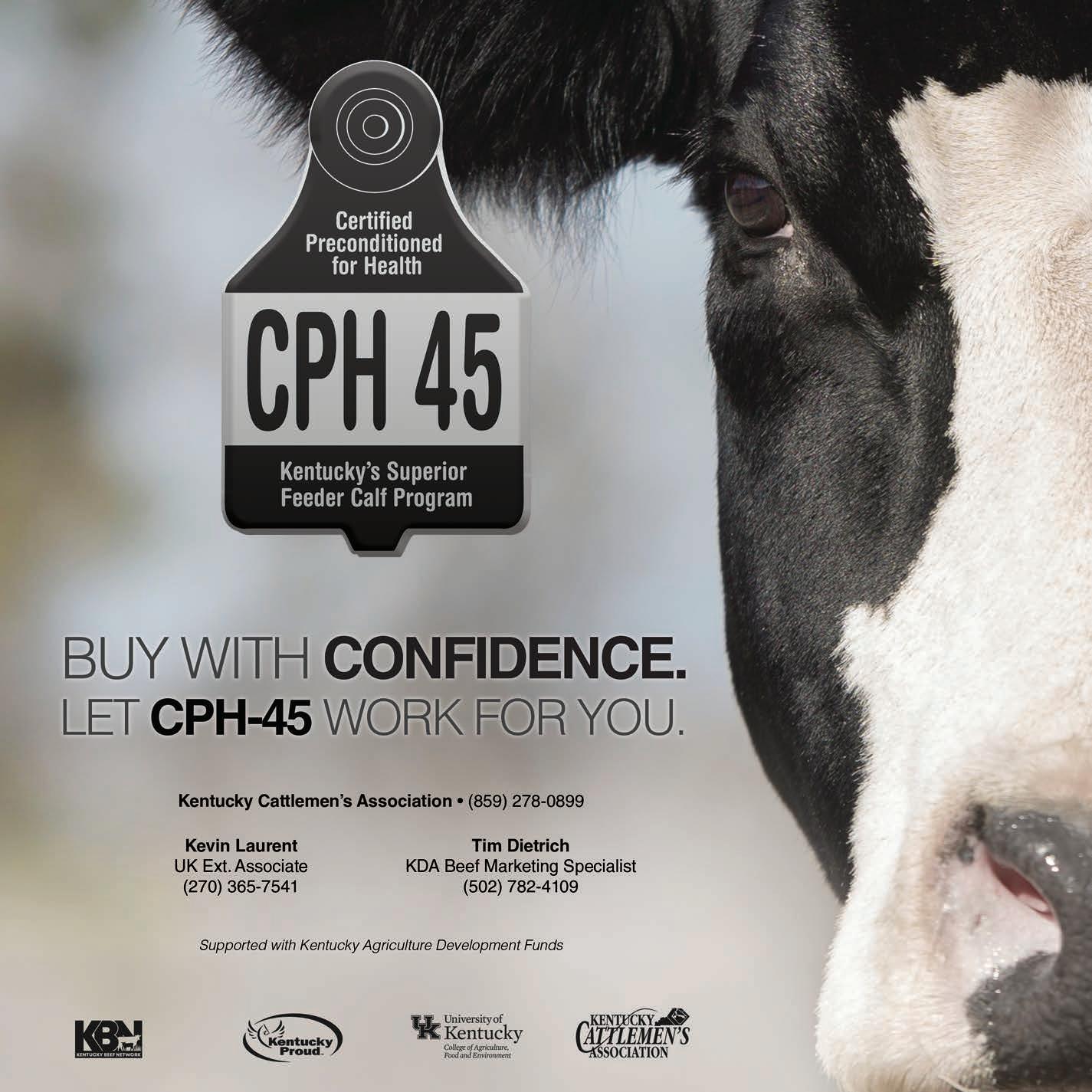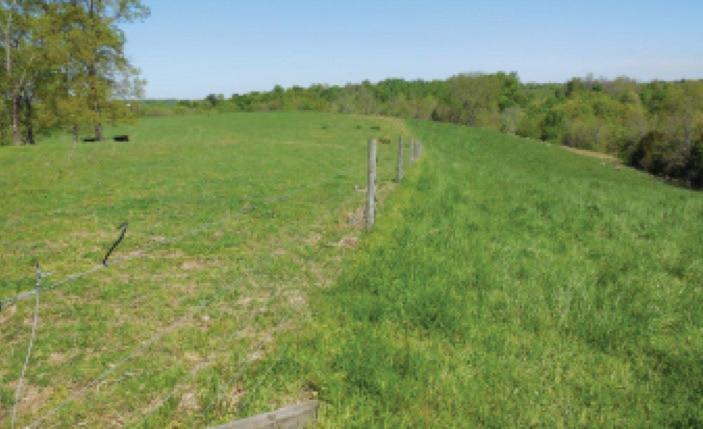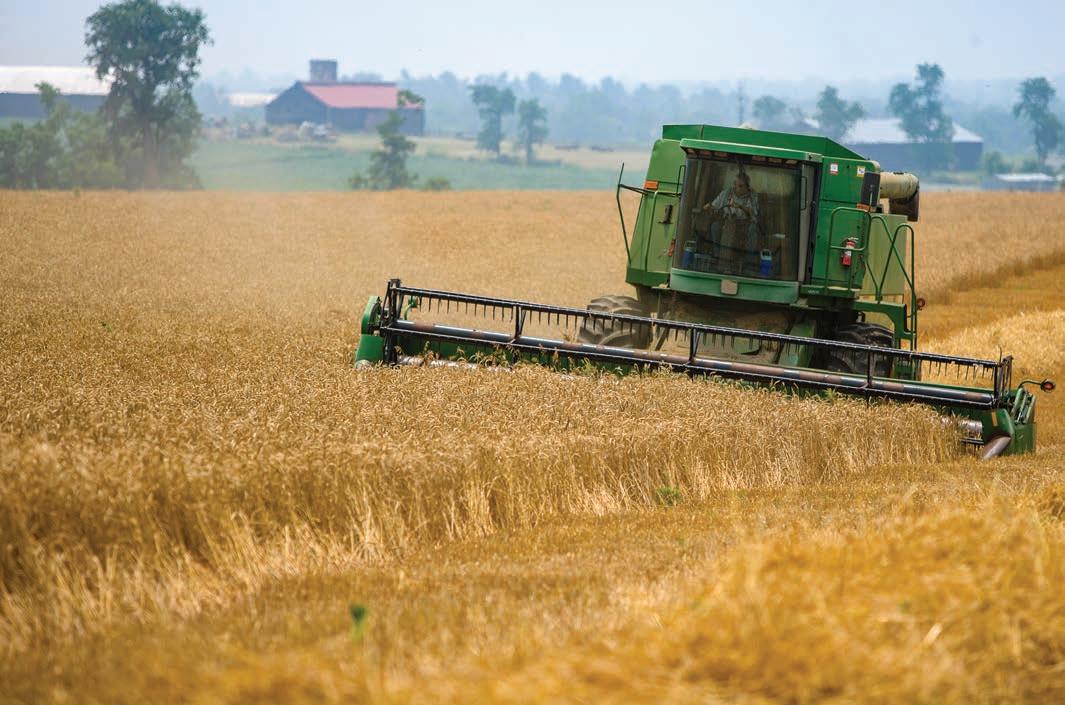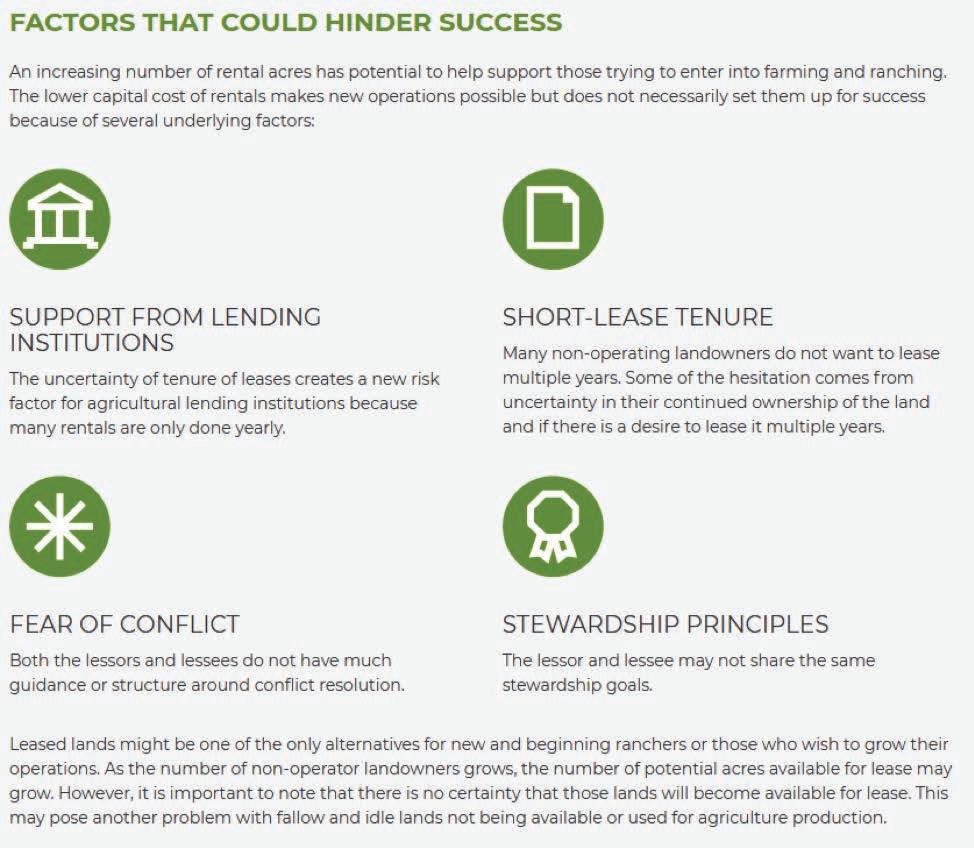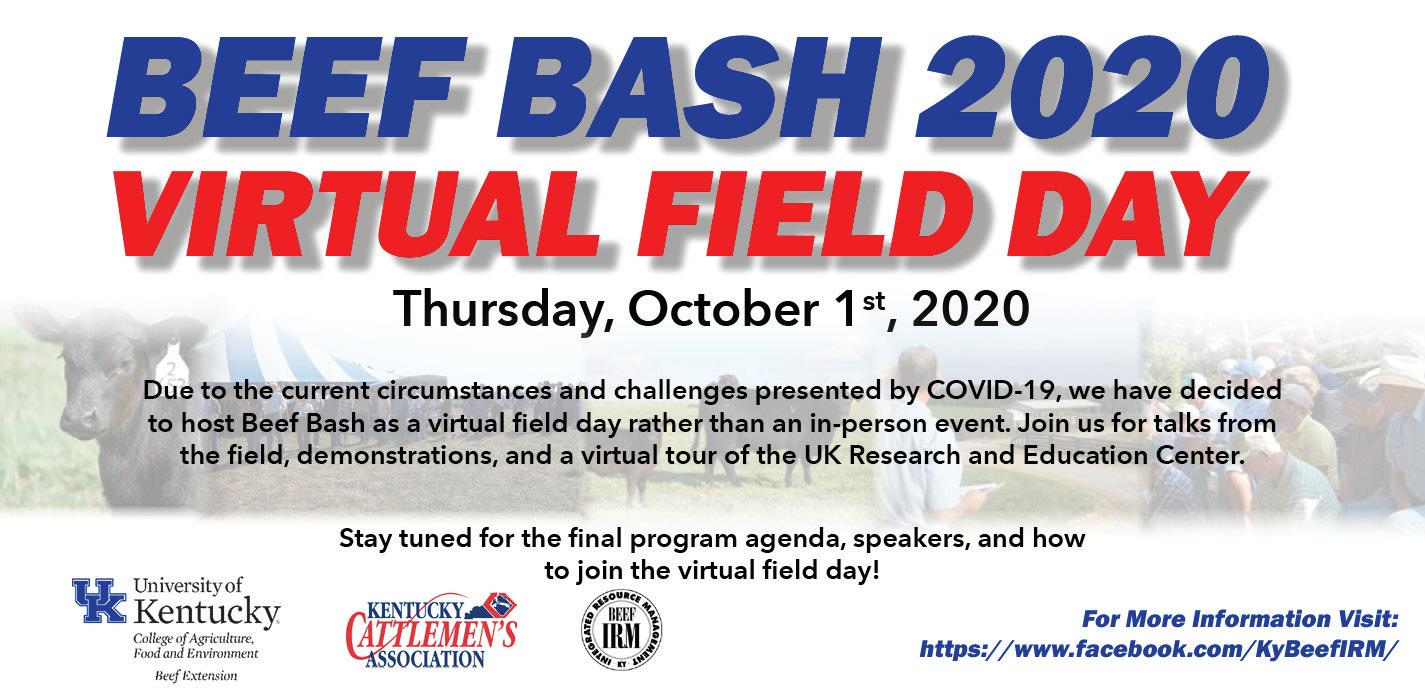
20 minute read
Chris T eutsch: The Hardest Part Is Just Getting Started
THE HARDEST PART IS JUST GETTING STARTED!!!
CHRIS D. TEUTSCH
UK Grain and Forage Center of Excellence, Princeton, Kentucky
Sometimes we make things too complicated! Rotational grazing is a perfect example. When we start talking about building fence, installing waterers, and moving animals two or three times a week, most livestock producers put the brakes on rotational stocking. I think that it is important to realize that it is perfectly okay to ease into rotational grazing. You don’t have to make a big investment or move animals every other day. The most important thing is that you just get started! Fine tuning your grazing system will come with time. In the remainder of this article I would like to share with you the birth of a rotational grazing system on a farm in far western Kentucky and a few tips that may help youtakethatfirststep.
Benefits of Rotational Stocking
The first thing that I would like to do is remind you of the benefits of rotational stocking. Although rotational stocking does have many tangible benefits, it is not a “silver bullet” that is going to solve all of your problems. If your stocking rate is too high, it is going to be verydifficult to maintain healthy pastures without designating and utilizing a sacrifice area to feed hay in. It is also important to remember that long-term change in pastures is a slow process and once you improve grazing management it can still take 3 or 4 years to make substantial change. Improved pasture growth. A review of the scientific literature shows that rotationally stocked systems are on average 30% more productive than continuously stocked systems. This is a result of being able to rest pastures between grazing events and to control how closely plants are grazed. Leaving some residual leaf area allows the plant to capture sunlight through photosynthesis. The energy captures in the form of sugars and carbohydrates can then be used to fuel regrowth of the plant. Pastures that are rested and not grazed too closely simply regrow faster. Improved nutrient distribution. In large continuously grazed pastures, animals tend to concentrate nutrients near shade and water sources. As we subdivide larger pastures into smaller ones, we will improve nutrient distribution. Animals are encouraged to defecate and urinate in the same areas that are being grazed. The smaller the paddocks, the more uniform the nutrient distribution is. Improved drought tolerance. One of the first things that producers notice when switching from a continuous to rotational grazing system is that their pastures grow longer into a drought and recover faster after the drought is over. This is a directly related to the health and size of the plant’s root system. Continuously stocked pastures tend to have smaller root systems that explore a smaller soil volume for water Fewer weeds in pastures. Maintaining a healthy stand of desirable forage species is the best way to prevent weeds in pastures. In a continuously stocked system, we tend to graze pastures closely and frequently, causing the sod to weaken and open up, leaving a space for weeds to flourish. Better animal handling. One of the benefits of rotational stocking that we fail to talk about is the positive impact that it has on animal handling. In a continuously stocked system, we often have limited contact with our livestock and the only time they see us is when something bad happens. In a rotationally stocked system, we have much more frequent contact with our animals. And when we have this contact something good happens, they get fresh grass.
The Birth of a Rotational Grazing System
This spring, Larry and Jana Clark bought a 50-acre farm in Graves County. They installed a perimeter fence and tackled a well-established weed problem. Jana who had attended several pasture management programs in Western Kentucky, had the long-term goal of setting up a rotational grazing system. This would require installing a watering system and subdividing pastures and was not feasible to accomplish in the near future. After visiting with Larry and Jana about their weed issues, we came up with a simple design that could be implemented with temporary fencing (Figure 2). It
Figure 1. The proportional advantage of rotational stocking compared to continuous stocking (Adapted from Conservation Outcomes from Pastureland and Hayland Practices-Assessment, Recommendations, and Knowledge Gaps, USDANRCS).
is NOT perfect because it allows back grazing of Paddock number 4 where the water is located, and animals must travel several thousand feet to get to water from the furthest paddock. However, it is better than continuously stocking the entire 50 acres. The system was set up in less than 3 hours using 100 step-in fence posts and 3000 ft of polywire on three geared reels (Figure 3). The cows and Jana (Figure 4) were trained to the polywire quickly. And so, a rotational grazing system was born in Graves County, KY! Many of you have had bad experiences with temporary electric fencing. In most

Figure 2. A 50-acre pasture located near Mayfield, KY was subdivided using a solar fence charger and temporary electric fencing into four pastures. Note that an alley was installed to allow livestock access to paddock 4 where water was located.
Figure 3. Setting up rotational grazing on Larry and Jana Clark’s farm in Graves County using temporary fencing. Larry and Jana Clark, Maryann Ellison, Jessica Buckman, Alex Teutsch, and Carrie Tarr-Janes (left to right).
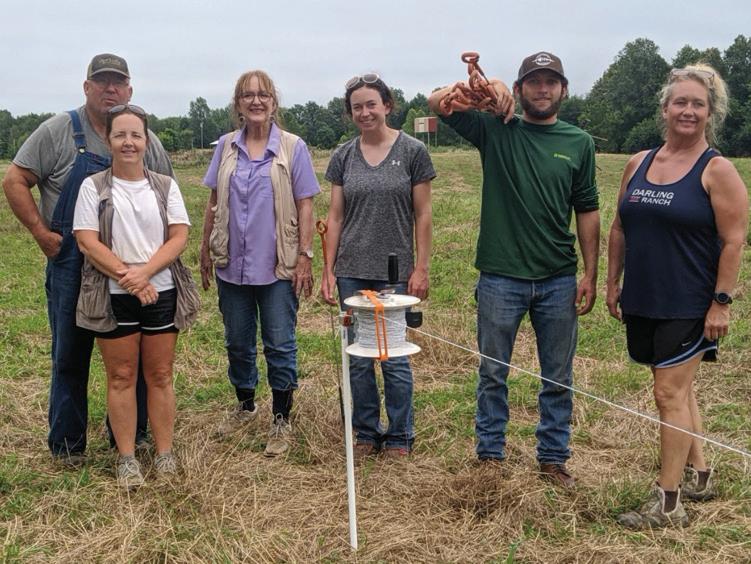

Figure 4. Electrified polywire provides an effective and economical means for subdividing pastures. In this photo Jana Clark is learning how to utilize a geared reel (without getting shocked). cases this is due to improper installation and not training the animals to the fence. For a single stand of polywire to control livestock, it needs to be hot, with a minimum of 5,000 volts, but preferably 6,000 volts. This means selecting the correct energizer and making sure that it is properly grounded. For tips on electric fencing, see this month’s fencing tip at the end of this article. Livestock must be trained to respect electric fencing. When training livestock, install a single hotwire 30 inches above the ground or nose height in an area that livestock will be able to cautiously approach it. Make sure that the engerizer and grounding system are optimized to deliver a knee buckling and eye watering shock. You want an animal’s first experience with an electric fence to be a bad one. Normally animals are trained to electric fencing in 2-3 days. Animals that cannot be trained to electric fencing should be culled. One of the big benefits of using polywire to make initial pasture subdivisions is that it is temporary. If you don’t like where it is, just move it. This becomes much more difficult when you install permanent fencing. I would highly recommend that you make your initial subdivisions with temporary fencing until you are 100% certain that is where you want your permanent fence. Currently, Larry and Jana will be rotating pastures every 1 to 2 weeks. Although the ideal interval for rotating pastures is 2-3 days, the most important thing is to just get started. Any rotation is better than none. Dry conditions during the summer months can often be a challenge for livestock producers. So what happens when you rotate through your pastures and get back to the first one and it has not regrown due to high temperatures and drought? Although it is tempting to open all the gates and let the animals roam, the best thing to do is to confine the animals to a sacrifice area and feed hay (Pasture 4). This keeps you from damaging pastures by overgrazing them during a drought. When the rain comes, your rested pastures will recover much more quickly than your neighbors. The hardest part about change is taking that first step. If need help getting started, give your local extension agent or conservation specialist a call! More information on grazing management can be found on the UK Forages website and the KYForages YouTube Channel. We would like to thank the Kentucky Beef Network and the Kentucky Agricultural Development Fund for their support of the Master Grazer Program and this demonstration. This month’s featured video is Us
ing Grazing Strategies to Improve
Soil Health on My Farm. This presentation was given as part of the 2014 Virginia Forage and Grassland Councils Winter Meeting Series. https://youtu.be/-OD3FnCd2dA This month’s featured publication is: “Electric Fencing for Serious Graziers,” USDA-NRCS. It can be accessed at the link below or you can find it at your local extension office. http://bit.ly/2Hw7vvy Fencing Tip: Use high quality temporary fencing. Temporary fencing comes in a number of styles including polywire, electric tape, electric braid, and polyrope. Electric tape should be used where high visibility is needed. Polywire is most commonly used by graziers since longer runs can be held on reels. When selecting polywire products, chose products that contain more strands of wire and for loner runs, choose products that contain wire made of mixed metals. Polywire containing mixed metals are about 40 times more conductive.
Forage Management Tips
Don ’t graze cool-season pastures closer than 3 to 4 inches.
This will help to lower crown temperature and reduce moisture loss from the soil.
Gr aze summer annual and perennial pastures to allow cool-season pastures to rest and to avoid toxic tall fescue.
Plant wint er annuals after the first good rain in August.
Plant alfalfa and other perennial cool-season grasses after the first good rain in August.
Ex clude livestock and apply 60 lb N/A in mid to late August for stockpiling.
Use UKY variety testing results to select varieties that will be planted in the fall.
If drought occurs, confine animals to one pasture and feed hay.
CATTLEMEN WELCOME LEGISLATION TO IMPROVE MEAT PROCESSING CAPACITY
Today, a bipartisan group of lawmakers introduced the Requiring Assistance to Meat Processors for Upgrading Plants (RAMP UP) Act, which provides federal incentives to improve beef processing capacity. Introduced by House Agriculture Committee Chairman Colin Peterson (D-MN), Reps. Frank Lucas (R-OK), Jeff Fortenberry (R-NE), Chellie Pingree (DME), Glenn Thompson (R-PA), Sanford Bishop (D-GA), David Rouzer (R-NC), Jim Costa (D-CA), Robert Aderholt (R-AL), and Angie Craig (D-MN), the RAMP UP Act will bolster market access for cattle producers and keep store shelves across the country stocked with wholesome and nutritious beef products. “The COVID-19 pandemic caused unprecedented disruptions to beef processing which were devastating to cattle producers,” said NCBA Vice President and Minnesota Cattlemen’s Association past president Don Schiefelbein. “The RAMP UP Act addresses these supply chain issues by ensuring cattle ranchers and farmers have robust access to new markets regardless of where their livestock is processed. We are grateful to Chairman Peterson and Rep. Lucas for their leadership and attention to this critical issue.” The RAMP UP Act authorizes federal grants up to $100,000 for existing meat processors to become federally inspected. Currently, state inspected and custom exempt processors cannot sell meat in interstate commerce and the process to become compliant with, and inspected by, the Food Safety and Inspection Service (FSIS) is expensive and daunting. If enacted, the RAMP UP Act would ease this burden on processors and benefit cattle producers by opening new markets for the beef they produce.
NCBA APPLAUDS INTRODUCTION OF DIRECT ACT
The National Cattlemen’s Beef Association (NCBA) today applauded the introduction of the bipartisan legislation to create new direct-to-consumer options for beef producers, processors and small meat markets without compromising federal food safety standards or market access under existing trade agreements. Introduced by U.S. Representatives Dusty Johnson (R - At-Large, SD) and Henry Cuellar (D - 28th Dist., TX), the Direct Interstate Retail Exemption for Certain Transactions (DIRECT) Act of 2020 would amend retail exemptions under current law to allow meat processed under stateinspected establishments to be sold across state lines through e-commerce, providing beef producers and local processors alike with more options to market direct-toconsumers. “Over the past few months, more Americans looked to e-commerce to purchase essential goods like beef and an already booming online marketplace further evolved to facilitate purchases and meet consumer demands,” said NCBA President Marty Smith, a family cowcalf operator from Wacahoota, Fla. “The American beef supply chain must evolve to keep up with the speed of commerce and the demands of modern-day consumers. The National Cattlemen’s Beef Association supports the DIRECT Act because it helps make it easier for the American cattle producer to meet the growing demand of the American consumer to purchase safe and delicious U.S. beef.”
Background
Currently, many states such as South Dakota and Texas have State Meat and Poultry Inspection (MPI) programs approved by the U.S. Department of Agriculture’s Food Safety and Inspection Service (USDA FSIS) as “at least equal to” standards set under the Federal Meat Inspection Act (FMIA) and Poultry Products Inspection Act (PPIA). Under the existing framework however, stateinspected products can only be sold interstate if approved to do so under the Cooperative Interstate Shipping Program (CIS). The DIRECT Act would amend the retail exemption under the FMIA and PPIA to allow processors, butchers or other retailers to sell normal retail quantities (300 lbs. of beef, 100 lbs. of pork, 27.5 lbs. of lamb) of MPI State Inspected Meat online to consumers across state lines. Because DIRECT Act sales are in e-commerce, sales are traceable and could easily be recalled. The proposal also includes clear prohibitions on export, keeping our equivalency agreements with trading partners intact. The DIRECT Act will allow states operating under the CIS system to ship and label as they are currently.
NCBA CELEBRATES IMPLEMENTATION OF USMCA TRADE DEAL
“We are the Envy of Many Countries,” Cattle Groups Say WASHINGTON (July 1, 2020) — The National Cattlemen’s Beef Association (NCBA) today celebrated the successful implementation of the U.S.-MexicoCanada Agreement (USMCA) by sending a joint letter of thanks to the leaders of all three nations. The letter was sent to President Trump, Canadian Prime Minister Justin Trudeau, and Mexican President Andrés Manuel López Obrador. It was signed by NCBA President Marty Smith, Canadian Cattlemen’s Association President Bob Lowe, and CNOG President Oswaldo Chazaro Montalvo. “Together, our organizations worked in unified support of USMCA because it protects market-based principles while making improvements in other sectors to reflect the needs of a modern North American economy, ” the leaders of the three cattlemen’s organizations wrote. “We are the envy of many countries because of the marketplace freedom USMCA will continue to provide both producers and consumers. “International trade is fundamental to the success of North American farmers and ranchers and the full value of the products we sell can only be achieved when we have access to the markets that most value them,” the letter continued. “In the face of the economic hardships of COVID-19, it is timely and welcome that USMCA enters into force, providing a foundation of economic stability for our rural communities and food systems.” Congress last winter overwhelmingly approved the new USMCA deal, with the Senate voting 89-10 in support of it a few weeks after the U.S. House of Representatives passed it with a strong bipartisan vote of 385-41. NCBA worked hard to build support for USMCA on Capitol Hill, and then-NCBA-President Jennifer Houston led a delegation of more than a dozen members to the White House to attend the official signing ceremony on Jan. 29. “We believe that our economies and our countries will be stronger together through USMCA,” the letter concluded.
NCBA HELPS LEAD COALITION TO CLOSE $630 MILLION SHORTFALL FOR INSPECTIONS OF AGRICULTURAL PRODUCTS
The National Cattlemen’s Beef Association (NCBA) today helped lead a coalition of more than 150 agricultural organizations in urging Congressional appropriators to close an estimated $630 million funding shortfall for the Customs and Border Protection’s (CPB’s) Agriculture Quarantine Inspection (AQI) at U.S. ports of entry. The coalition stated its case in a letter to members of the U.S. House and Senate Appropriations Committees. CPB Agriculture Specialists, Technicians, and Canine Teams inspect ag imports to prevent the entry of foreign plant and animal pests and diseases such as Food and Mouth Disease. The inspections are ordinarily funded by AQI user fees that are collected by USDA’s Animal and Plant Health Inspection Service (APHIS), but those user fees have dropped dramatically as international travel and cargo imports have been hit hard by the COVID-19 pandemic. The shortfall in funding for AQI at ports ofentry through the end offi scal year 2021 is estimated to be $630 million. “We urge Congress to ensure that the essential work of CBP agriculture inspectors continues uninterrupted throughout the COVID-19 pandemic,” the coalition’s letter said. “We depend on AQI to ensure that America’s agriculture sector remains safe from foreign animal and plant pests and diseases. It is inconceivable that Congress would risk widespread damage to U.S. agriculture and the overall economy by not funding these inspections.” “The pandemic has already had a devastating impact on our nation’s
The National Cattlemen’s Beef Association (NCBA) has represented America’s cattle producers since 1898, preserving the heritage and strength of the industry through education and public policy. As the largest association of cattle producers, NCBA works to create new markets and increase demand for beef. Efforts are made possible through membership contributions. To join, contact NCBA at 1-866-BEEF-USA or membership@beef.org.
citizens and on our economy,” said NCBA Executive Director, Government Affairs, Allison Rivera. “W e need to continue to fund our CBP Ag Inspectors and give them the resources they need so that they may continue to be vigilant at our ports of entry in order to keep out foreign animal diseases and pests. The group’s full letter and a list of signing organizations can be found here.
GOVERNMENT DIETARY GUIDELINES REAFFIRM BEEF’S ROLE IN A HEALTHY DIET
The National Cattlemen’s Beef Association (NCBA) today thanked the members of the 2020 Dietary Guidelines Advisory Committee (DGAC) for recognizing beef’s role in a healthy lifestyle, including the essential role of beef’s nutrients at every life stage. The DGAC released recommendations to the U.S. Department of Agriculture (USDA) and the U.S. Department of Health and Human Services (HHS) for the 2020 Dietary Guidelines for Americans (DGAs), the cornerstone of all federal nutrition policy. The beef community has made it a priority to protect the scientifi c credibility of Dietary Guidelines and promote accurate information about the nutritional advantages of beef as part of a balanced diet. NCBA, in its roles as both a contractor to the Beef Checkoff and as a member-driven policy association, submitted 21 sets of written comments, provided oral comments, and attended public meetings to ensure beef’s role in a healthy diet is recognized. “Cattle and beef producers appreciate the evidence-based recommendations of the DGAC. We believe beef is a wholesome, nutritious food that plays an important role in a healthy diet and we are supportive of many of the committee’s findings,” said NCBA CEO Colin Woodall. “NCBA and its members have made this work a priority for more than two years, and we’re pleased that the report reinforces the strong science which supports beef’s nutritional value in a healthy diet.” Woodall noted that the recommendations shared in the report mirror many of the recommendations related to red meat which were included in the 2015- 2020 DGAs. In fact, the amount of meat recommended for healthy diets in the current report is the same as the 2015 DGAs. He also pointed to current DGAC report findings that suggest many Americans would benefit from getting more nutrients like protein, iron and choline, which are readily available in beef. “This report also demonstrates that women of child-bearing age, adolescent boys and girls and older Americans are especially vulnerable to not getting enough of the nutrients found in beef, which further demonstrates beef’s valuable role in the diet,” said Woodall. While the DGAC report is influential in the development of the 2020 Dietary Guidelines for Americans, Secretaries Perdue and Azar are now tasked with reviewing the DGAC recommendations beforefinalizingthe2020Guidelines.The public comment period for the report is open now until Aug. 13, 2020. NCBA will be calling on its producer members to provide comments and looks forward to continued engagement as the Secretaries of USDA and HHS work to fi nalize the guidelines.
NCBA LEADS FIGHT ON CAPITOL HILL TO PROVIDE ADDITIONAL PANDEMIC RELIEF FOR CATTLE PRODUCERS
The National Cattlemen’s Beef Association (NCBA) today sent a letter to leaders on Capitol Hill thanking them for their efforts in supporting our Nation’s cattle producers through the Coronavirus Aid, Response, and Economic Security (CARES) Act and urging them to continue their work by improving the Coronavirus Food Assistance Program (CFAP). NCBA Vice President of Government Affairs Ethan Lane issued the following statement: “The assistance provided to rural America through the CARES Act represented a critical step toward ensuring U.S. cattle producers remain operationally viable in the short-term during the height of COVID-19. However, as our nation collectively works to rebound from this pandemic, we have a clearer understanding of the challenges that remain for our industry, as well as the long-term solutions needed to facilitate a robust recovery. While CFAP was a good start, these cattle assistance payments can be improved upon and tailored to provide additional support to those in our industry whohavebeenespeciallyaffected by market disruption from the COV ID-19 pandemic. Additionally, further measures such as emergency haying and grazing under the Conservation Reserve Program, a fed-cattle set aside pilot program, and the waiving of overtime fees for Federal Meat Inspectors can be utilized by Congress to ensure the beef supply chain is stronger moving forward.”
NCBA RESPONDS TO CONGRESSIONAL CLIMATE REPORT
“EVERY CATTLE PRODUCER PLAYS ROLE IN CATTLE’S POSITIVE CLIMATE IMPACT” National Cattlemen’s Beef Association Vice President, Government Affairs, Ethan Lane today released the following statement in response to a new Congressional report on climate change: “The report released today by the House Select Committee on the Climate Crisis is unfortunately the product of partisan discussions that failed to encompass important constituent communities across the country. NCBA is committed to working with Congress to fi nd real solutions that set us on a path toward long-term environmental and economic sustainability. “All segments of the beef supply chain – ranchers, feeders, haulers, processors, and retailers – play a necessary role in ensuring that beef consumption is a climate solution. Every cattle producer plays a role in cattle’s positive climate impact. Pasture-based operations cultivate healthy soil to improve carbon storage, grazing reduces fi ne fuels that contribute to catastrophic wildfi re that causes significant air pollution and longterm damage to soil and water health, and advancements in feed efficiency directly reduce methane emissions. According to the U.S. Environmental Protection Agency, methane from beef cattle accounts for only 2% of the United States’ greenhouse gas emissions while providing a host of opportunities for improved carbon storage in landscapes across the country. “NCBA will continue working to ensure that all segments of the beef supply chain are recognized for their benefi cial contributions and do not face punitive measures that unfairly or inaccurately targetdomesticfoodandfiberproduction. Voluntary, inventive-based conservation is the most fruitful path to conserving America’s agricultural land through increased adoption of sustainable management practices. Consistent, achievable conservation goals ensure that all farmers and ranchers, regardless of size or segment, have the necessary resources to continue producing the world’s safest beef.”
NCBA WELCOMES FORWARD PROGRESS ON FMD VACCINE BANK
The National Cattlemen’s Beef Association’s (NCBA) today released the following statement in response to the United States Department of Agriculture (USDA) securing contracts worth $27.1 million to provide foot-and-mouth disease (FMD) vaccines for the National Animal Vaccine and Veterinary Countermeasures Bank (NAVVCB) that was created in the 2018 Farm Bill at the request of NCBA: “We are pleased to see USDA is moving forward with creating a supply of FMD vaccines in the NAVVCB to ensure ranchers and farmers have timely access to acriticaltoolinthefi ght againstforeign animal diseases, such as FMD. This is a promising fi rst step forward to begin the work authorized in the 2018 Farm Bill; but, more action is needed to strengthen this newly created vaccine bank,” said NCBA Executive Director of Government Affairs, Allison Rivera. “NCBA will continue to work with USDA, Congress, and other stakeholders to secure future funding, making certain that the entire cattle industry is better prepared for a possible outbreak of FMD.” NAVVCB is one component of a three-part program established by the 2018 Farm Bill to comprehensively support animal disease prevention and management. This new program adds to the nation’s level of protection against this devastating disease. In the event of an outbreak, animal health officials would decide when, where, and how to use the available vaccine based on the circumstances of the outbreak. NCBA and other members of the animal agriculture community strongly lobbied Congress to include the formation of the NAVVCB in the Farm Bill to provide additional vaccine for use in livestock disease outbreaks, such as FMD.

